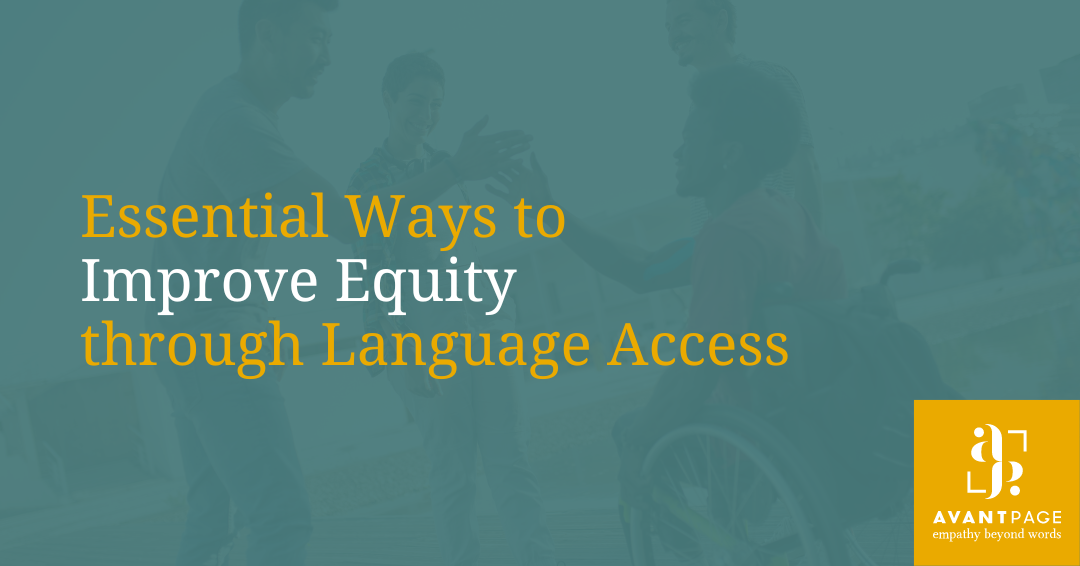To improve equity, one step your organization can take is to provide or expand language access for limited English proficient (LEP) individuals and communities. Language access may present itself in many ways: translated website or content, interpreters at healthcare appointments, language assistance during election time, and more.
We’ve provided six essential ways to improve equity through language access for organizations looking to provide or expand on their language access services.
1. Track LEP Audience Language Access Data
Start by figuring out a process to identify, track, and report on Limited English Proficient (LEP) audiences across your organization. Having robust and accurate data will enable you to inform language access queries, leading to support for the LEP community. It’s important to track this data at micro-local and/or at the program level, because languages might be more prominent in specific areas than what’s prominent at state or even county levels. Some ways to collect LEP audience information include:
- Determine what your threshold languages are by using the latest US Census Map and Google Analytics.
- Survey internal and external customers.
- Consult with your language service provider (LSP).
- Reach out to other similar organizations and cultural organizations in your area.
LEP audience data helps organizations plan for language access support and implement initiatives, leading to a better understanding and response to changing demographics and needs.
2. Plan Early for Language Access Initiatives
Language access shouldn’t be an afterthought—it’s much easier, more efficient, and less costly to plan ahead. Suppose you’re considering localizing your website into other languages. In this case, you’ll want to make sure that your website is reviewed for internationalization, meaning that it can handle language nuances (e.g., Chinese characters require double-byte codes). Identifying and fixing language requirements before you’re ready to localize your website will save money and time in development costs and prevent delays in launching localized sites.
In addition, numerous tools can help improve equity while saving time and money on translation costs for content. For example, preparing a terminology database with technology like AvantMemory before content is translated provides content consistency, reduces costs, and decreases time-to-market. In addition, creating content using plain language can benefit both the audience by making content easier to understand and an organization by reducing translation costs. While you can still use these tools after content is developed, you get the most out of them early on in the process.
Consider proactively integrating funds, resources, and planning for language access into all organizational programs early on.
3. Create and Track Language Access Plans
A language access plan is a policy describing how an organization will provide language services to support LEP individuals and improve equity. The content of a language access plan varies since there’s not a standard template; however, it generally includes topics such as data about the LEP population, services offered, policies and procedures, training, budgets, and more.
Federal regulations require a language access plan for schools and government agencies. Even if a plan isn’t required, it can help an organization focus and put a policy around language services to ensure you’re providing the best possible services.
An LSP who works with government agencies and educational institutions should be quite familiar with language access plans and be able to provide some guidance. An LSP may also know the area, what other organizations are doing, and what’s working. Reach out to your LSP to see how they can help.
4. Establish Accountability Measures to Improve Equity
Establish accountability measures that include equity indicators across all levels, both for the LEP community and internally, to ensure that you can provide adequate staff to support your language initiatives. These measures can be built into a language access plan. Here are some examples of the kinds of measures you can put in place:
- Create a staffing plan to support language access initiatives, and consider dedicating internal resources/titles to specifically support and monitor initiatives.
- Design or find a cultural diversity and linguistic skills development plan for staff.
- Change internal practices to include initiatives.
- Implement processes to monitor customer service through a Culturally and Linguistically Appropriate Services (CLAS) lens.
- Include KPIs that track the effectiveness of internal processes on external benefits for LEP community members.
- Evaluate how you can gather customer data through social media, follow-up surveys, etc. to determine how equitable the services or product is.
5. Create Language Access Community Hubs
Be resourceful, and learn more about other organizations to gain insights, information, and ideas for strategies. Create community hubs, partner with interagency groups for ideas and resources, and use overarching bodies that already have language access in implementation.
For example, digital.gov has a multilingual community as well as multiple resources around translations. In addition, many grants are available—look for ones that promote equity in Social Determinants of Health (SDOH). Also, contact your local government to see what resources may be available. Finally, your LSP should be a great resource, given that they see many organizations and have ideas about where to go for help.
6. Create Cultural and Linguistic Partnerships
Like community hubs, partner organizations that work with LEP individuals and communities are key to high quality and responsiveness language access. Organizations should find and partner with local communities, non-profits, and organizations to target LEP communities in their outreach. These organizations have cultural and linguistic skills and the connections to ensure leveraged outreach.
Conclusion
Expanding language access helps improve equity for LEP individuals and communities. Organizations can improve through services using the tips in this blog post.
We localize websites, translate content, provide interpreter services, and more. If you need help getting started, contact us at [email protected] or (530) 750-2040.
